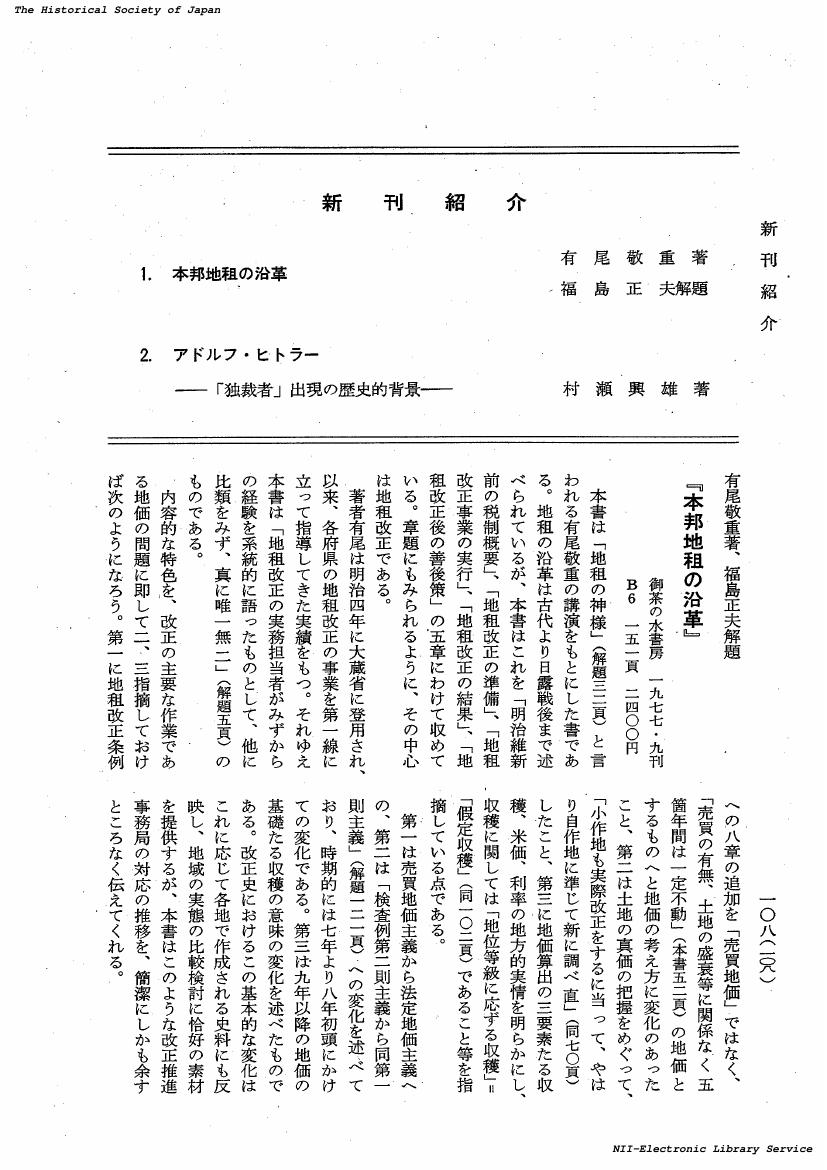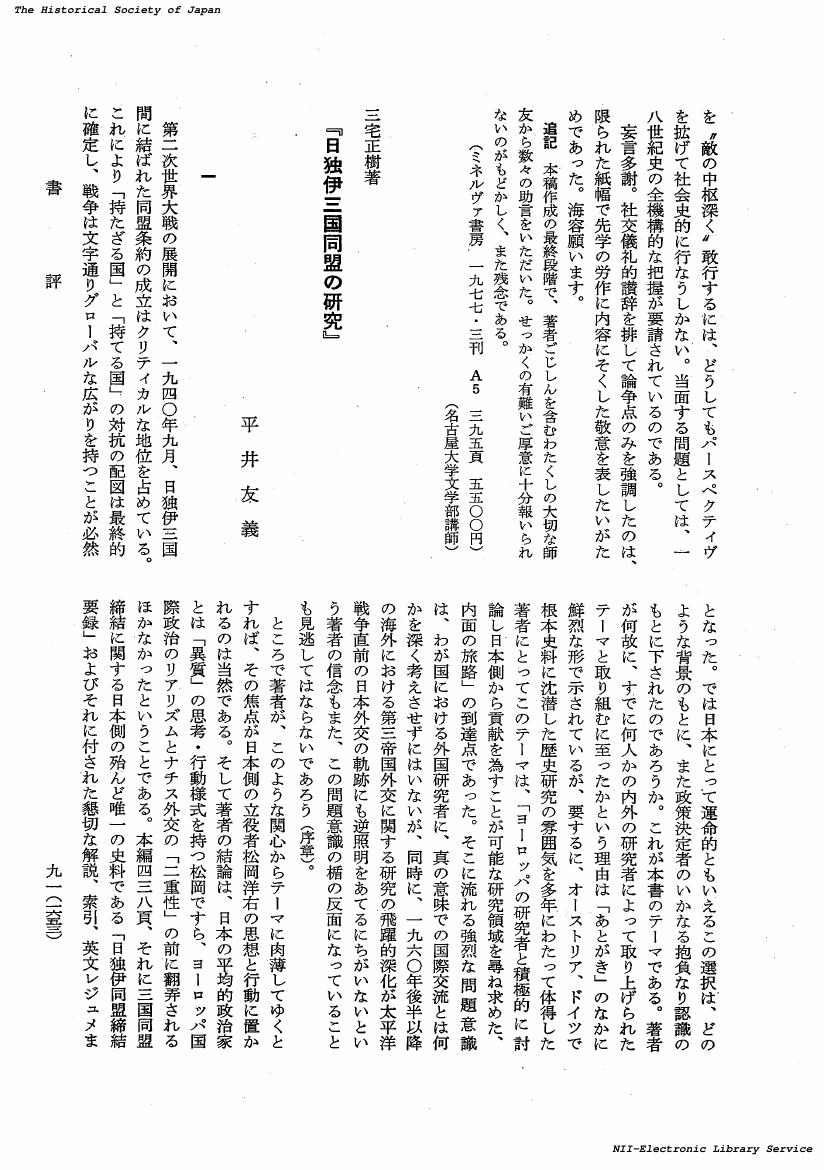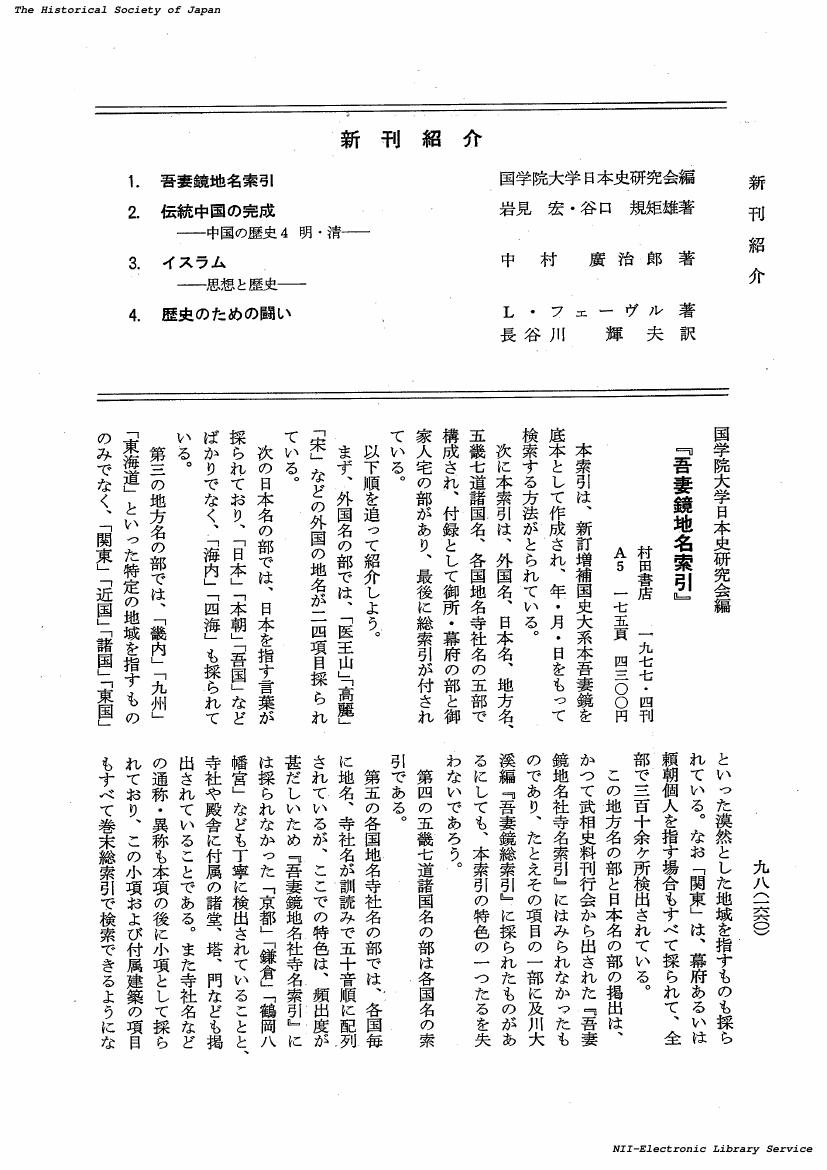1 0 0 0 OA 日朝貿易における白糸・絹織物の輸入と京都販売
- 著者
- 田代 和生
- 出版者
- 公益財団法人 史学会
- 雑誌
- 史学雑誌 (ISSN:00182478)
- 巻号頁・発行日
- vol.87, no.1, pp.44-67,137-136, 1978-01-20 (Released:2017-10-05)
It has often been said that white raw silk and fabrics were imported into Tokugawa Japan only through Nagasaki. However, this opinion overlooks the silk imports that came into Japan, with government authorization, through Tsushima-han. Such silk and silk fabrics were originally made in China but transmitted to Japan by Korean merchants. The quantity of this trade was fairly large by the late seventeenth century, and sometimes it even exceeded that of the Nagasaki silk trade. The price of silk and silk fabrics imported to Japan through Korea was generally lower than similar goods coming in through Nagasaki. The silk and silken fabrics were brought to the central market town, Kyoto, and sold from Tsushima-han to two wholesale merchants, Chosen-donya 朝鮮問屋 and Fukaeya 深江屋 who was financed by the great merchant Mitsui 三井 (Echigoya 越後屋). This marketing occurred completely independently of the Nagasaki route. At the same time it is important to note that the silver ingot called Chogin originated in Kyoto, and also was the main export good from Tsushima-han to Korea. This silver eventually flowed onto China. Thus, an international silk and silver trade between Japan and China via Tsushima and Korea was established in Tokugawa Japan with Kyoto functioning as the entrepot at the Japanese end of this route. Many problems and even facts of the marketing of imported goods in Tokugawa Japan have been ignored for a long time by historians. By studying a major component of this neglected trade, the Korean trade of Chinese silk, the author has tried to clarify the developments and market structure of this trade.
1 0 0 0 OA 辛島昇編『インド史における村落共同体の研究』
- 著者
- 長崎 暢子
- 出版者
- 公益財団法人 史学会
- 雑誌
- 史学雑誌 (ISSN:00182478)
- 巻号頁・発行日
- vol.87, no.1, pp.96-102, 1978-01-20 (Released:2017-10-05)
- 著者
- 渡辺 隆喜
- 出版者
- 公益財団法人 史学会
- 雑誌
- 史学雑誌 (ISSN:00182478)
- 巻号頁・発行日
- vol.87, no.1, pp.108-109, 1978-01-20 (Released:2017-10-05)
- 著者
- 志垣 嘉夫
- 出版者
- 公益財団法人 史学会
- 雑誌
- 史学雑誌 (ISSN:00182478)
- 巻号頁・発行日
- vol.86, no.11, pp.1663-1664, 1977-11-20 (Released:2017-10-05)
1 0 0 0 OA 「ネップ」初期研究 : 「商品交換体制」の成立をめぐって
- 著者
- 石井 規衛
- 出版者
- 公益財団法人 史学会
- 雑誌
- 史学雑誌 (ISSN:00182478)
- 巻号頁・発行日
- vol.86, no.12, pp.1691-1734,1817, 1977-12-20 (Released:2017-10-05)
1 0 0 0 OA 佐脇栄智著『後北条氏の基礎研究』
- 著者
- 池上 裕子
- 出版者
- 公益財団法人 史学会
- 雑誌
- 史学雑誌 (ISSN:00182478)
- 巻号頁・発行日
- vol.86, no.12, pp.1735-1741, 1977-12-20 (Released:2017-10-05)
1 0 0 0 OA 仲手川良雄著『ブルクハルト史学と現代』
- 著者
- 坂井 直芳
- 出版者
- 公益財団法人 史学会
- 雑誌
- 史学雑誌 (ISSN:00182478)
- 巻号頁・発行日
- vol.86, no.12, pp.1755-1764, 1977-12-20 (Released:2017-10-05)
1 0 0 0 OA 小坂 博之著『山名常〓と禅刹』, 楞厳寺, 一九七六・九刊, A5, 二三〇頁
- 著者
- 田中 博美
- 出版者
- 公益財団法人 史学会
- 雑誌
- 史学雑誌 (ISSN:00182478)
- 巻号頁・発行日
- vol.86, no.12, pp.1788-1790, 1977-12-20 (Released:2017-10-05)
- 著者
- 内河 久平
- 出版者
- 公益財団法人 史学会
- 雑誌
- 史学雑誌 (ISSN:00182478)
- 巻号頁・発行日
- vol.86, no.12, pp.1790-1791, 1977-12-20 (Released:2017-10-05)
1 0 0 0 OA 庄内藩の寛政改革と農村構造
- 著者
- 吉村 仁作
- 出版者
- 公益財団法人 史学会
- 雑誌
- 史学雑誌 (ISSN:00182478)
- 巻号頁・発行日
- vol.86, no.11, pp.1563-1596,1690-, 1977-11-20 (Released:2017-10-05)
This article is intended to examine the basic agrarian policy executed in the end of the 18th century and the early part of the 19th century in the Shonai clan, and through it to throw light upon the characteristics of the social structure of the rural community at the period. The Shonai clan at that period, especially in the end of the 18th century when the Kansei Reform was started, saw the devastation of the rural community so terrible that an expression of a "structural crisis" is given to it. The devastation was concretely shown in the collapse of agriculture management under the severe exploitation, the joint management by the village community of the lands whose occupiers ran off, the exploitation by the usurious capital, the yoke of the organization for tax collection, the accumulation of land by landowners, and so on. The clan confronted with those problems tried to restore the village community by the adjustment of the government organization, the reorganization of the mercantile and usurious capitalists, the policy of land redemption, that is the one of settling occupiers on their lands, and so forth. The social structure of the village community at that period was characterized by the joint operation of deserted lands according to the village customs (mura-sozukuri) and the landowner-tenant relations through the village community. Both were the two manifestations or ways of the same conflict in the village social structure. The policy of settling occupiers on their lands was the basic policy adopted in the reform for maintaining the system of the peasant proper (hon-byakusho). The policy was intended to meet the conflict in the village, but at the same time it could not help being restricted by the village customs. The peasantry had "struggles" by relying upon the customs, and this was the basic form of class conflict at this period. Therefore, however, the decisive aggravation of class conflict waited till the closing years of the Bakufu and the Restoration period when the village community began to gravely disintegrate and reorganize itself. And the trend of poor peasants with various forms of existence in landowner-tenant relations can be used as an index of the aggravation of class conflict.
1 0 0 0 OA 細川行信著『真宗成立史の研究』
- 著者
- 重松 明久
- 出版者
- 公益財団法人 史学会
- 雑誌
- 史学雑誌 (ISSN:00182478)
- 巻号頁・発行日
- vol.86, no.11, pp.1629-1638, 1977-11-20 (Released:2017-10-05)
1 0 0 0 OA 森田 明著『清代水利史研究』
- 著者
- 濱島 敦俊
- 出版者
- 公益財団法人 史学会
- 雑誌
- 史学雑誌 (ISSN:00182478)
- 巻号頁・発行日
- vol.86, no.11, pp.1638-1646, 1977-11-20 (Released:2017-10-05)
1 0 0 0 OA 岸田 紀著『ジョン・ウェズリ研究』
- 著者
- 近藤 和彦
- 出版者
- 公益財団法人 史学会
- 雑誌
- 史学雑誌 (ISSN:00182478)
- 巻号頁・発行日
- vol.86, no.11, pp.1646-1653, 1977-11-20 (Released:2017-10-05)
1 0 0 0 OA 三宅正樹著『日独伊三国同盟の研究』
- 著者
- 平井 友義
- 出版者
- 公益財団法人 史学会
- 雑誌
- 史学雑誌 (ISSN:00182478)
- 巻号頁・発行日
- vol.86, no.11, pp.1653-1659, 1977-11-20 (Released:2017-10-05)
- 著者
- 山本 博也
- 出版者
- 公益財団法人 史学会
- 雑誌
- 史学雑誌 (ISSN:00182478)
- 巻号頁・発行日
- vol.86, no.11, pp.1660-1661, 1977-11-20 (Released:2017-10-05)
- 著者
- 山名 弘史
- 出版者
- 公益財団法人 史学会
- 雑誌
- 史学雑誌 (ISSN:00182478)
- 巻号頁・発行日
- vol.86, no.11, pp.1661-1662, 1977-11-20 (Released:2017-10-05)
- 著者
- 安藤 正人
- 出版者
- 公益財団法人 史学会
- 雑誌
- 史学雑誌 (ISSN:00182478)
- 巻号頁・発行日
- vol.86, no.10, pp.1533-1534, 1977-10-20 (Released:2017-10-05)
1 0 0 0 OA 後藤 靖編『天皇制と民衆』, 東大出版会, 一九七六・一〇刊, 四六判, 二〇七頁
- 著者
- 宮地 正人
- 出版者
- 公益財団法人 史学会
- 雑誌
- 史学雑誌 (ISSN:00182478)
- 巻号頁・発行日
- vol.86, no.10, pp.1534-1535, 1977-10-20 (Released:2017-10-05)
1 0 0 0 OA 矢島祐利著『アラビア科学史序説』, 岩波書店, 一九七七・三刊, B6, 四四五頁
- 著者
- 田中 一郎
- 出版者
- 公益財団法人 史学会
- 雑誌
- 史学雑誌 (ISSN:00182478)
- 巻号頁・発行日
- vol.86, no.10, pp.1536, 1977-10-20 (Released:2017-10-05)
- 著者
- 石田 智子
- 出版者
- 公益財団法人 史学会
- 雑誌
- 史学雑誌 (ISSN:00182478)
- 巻号頁・発行日
- vol.85, no.2, pp.222-223, 1976-02-20 (Released:2017-10-05)

















